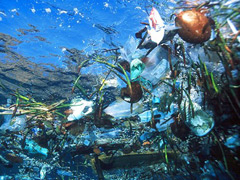Floating Pacific Garbage Patch: Updated with new info
Oct 21
Poisonous floating islands of plastic and garbage are focus of newer waste to energy technology. Turning such an incredible negative impact on the environment into a potential source for alternative energy generation.

Some people have called it “the plastic island”, and according to them, it poses an enormous threat to the environment of the whole planet. However, others claim that it actually has great potential for alternative energy generation. There are waste to energy programs, which may turn the great pacific garbage patch into electricity and heat for homes and offices. Waste to energy power plants convert solid waste (even plastics) into energy. These waste to energy programs create a win-win situation in the case of the pacific ocean garbage patches. The trash would be taken out of the ocean, leaving the marine life and the birds unaffected by toxins, and energy can be generated by non-polluting methods.
These Pacific Ocean garbage patches have created an amazing opportunity for green energy. There are shortages of energy all over the world and fossil fuels are damaging the environment more and more, so something has to be done. Using the great pacific garbage patch for a plant under a waste to energy project could turn an environmental threat into an alternative energy source.
Waste to energy programs are a great way to turn pollution into energy. Such technology can prevent 40 million metric tons of emissions of greenhouse gas (in carbon dioxide equivalent form) from being released into the atmosphere every year. Waste to energy programs also prevent nearly 2.6 million tons of volatile organic compounds and 24,000 tons of nitrogen oxides from being released into the atmosphere.
The current way to get rid of garbage is land disposal, which causes the release of methane, which is a powerful greenhouse gas, as this garbage decomposes. Waste to energy facilities are a clean alternative to this and can also produce electricity. Their main benefit, of course, is decreasing reliance on power plants that result in carbon dioxide emissions when oil and coal are burned, which result in one of the worst kinds of greenhouse gas emissions into the atmosphere. Waste to energy plants do not release methane into the atmosphere, which would otherwise occur when the trash decomposes. They also avoid the release of CO2, which is usually released when generating electricity using fossil fuels.
For the original article, click here
en.wikipedia.org/wiki/Great_Pacific_Garbage_Patch,
en.wikipedia.org/wiki/North_Pacific_Gyre
Related Posts
- Converting Municipal Waste to Renewable Energy Source
- Production of Green Energy From Municipal Waste
- Bioconversion of Food Waste for Energy Production - Updated Article With Extra Information
- Converting Municipal Waste to Renewable Energy Source - Updated Article With Extra Information on Waste to Renewable Energy
- Cost Effective Waste to Energy Technologies
4 Responses to “Floating Pacific Garbage Patch: Updated with new info”
You Can Use This Form to Leave Your Feedback or Ask Additional Question
You must be logged in to post a comment.





I was in Colombia recently and saw how a family disposed of its (including plasic bottles) trash by through it into the river. This river led into the Pacific ocean. Here is the problem – generations of people who have had access to biodegradable only products, suddenly get everthing in plastic wrapping, and we can see the consequences!
September 28th, 2010 at 1:49 pmthe plastic does not biodegrade, but instead it photodegrades – which means that the suns rays break the plastic down, and that is why the majority of the garbage patch consists of small bottles. These small particles turn into fine dust – impossible to clear up
September 28th, 2010 at 1:46 pmGood idea how can we stop talking about this issue and actually do something that works?!
February 7th, 2010 at 4:48 pmAn interesting concept. What is the comparison of energy to collect and transport the plastic from the great pacific garbage patch to where it can be converted into energy?
Also, I am interested to know how “energy would be created using methods that do not contribute to global warming or pollution”, what methods could achieve this?
It appears to me that collect of the smaller plastic fragments is crucial to improving oceanic ecosystems, how will these small molecular sized pieces of plastic be collected?
Thanks very much.
April 20th, 2009 at 2:23 pm